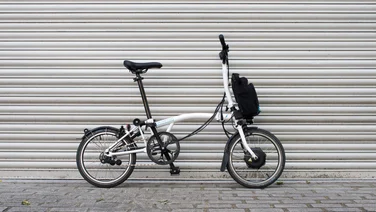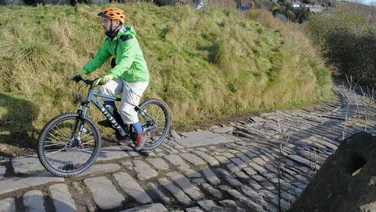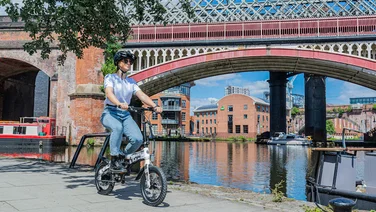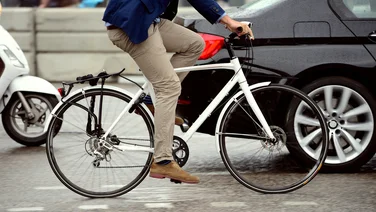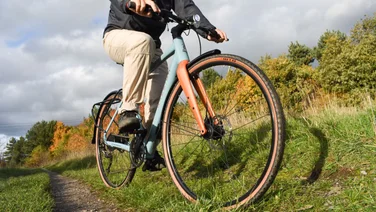To help us provide you with free impartial advice, we may earn a commission if you buy through links on our site. Learn more












- Lightweight
- Very attractively priced
- Easy to pedal without power
- Small capacity battery
- Lengthy lead time from ordering to delivery
If you thought fitting an e-bike kit was a complicated business, Swytch is here to make you think again. Three main components of its conversion kit come ready to fit to just about any bike, and the newly redesigned battery is amazingly portable.
Swytch e-bike conversion kit review: What do you get for the money?
We looked at the previous version of the Swytch kit in its Brompton-specific form back in late 2020 and liked it. “It’s rough around the edges when it hits its 15.5mph assistance limit but, for the most part, this kit hits the mark. It’s very light, simple to fit to an existing Brompton and delivers more than enough power assistance,” we said.
Now the Swytch kit is back and it has been significantly redesigned. The sprightly front hub motor and the pedal sensor are the same but there’s a new, much lighter, battery and a redesigned battery mount. I’ve tried it out not only on the famously compact folding Brompton but also on a sporty hybrid bike and a heavier town bike to see how it performs across different designs.
There are two battery options you can choose between. Swytch says the smallest – called the Air – is 70% smaller than the original battery and 50% lighter, and it’s really very compact. It weighs less than a kilogram at 700g, measures 20 x 10 x 2.5cm and delivers 98Wh of capacity. The bigger Max version is 1.4cm longer, twice as thick and has double the capacity at 198Wh. I tested the Air version.












There’s also a new quick-release mounting system built from lightweight alloy instead of the plastic clamp of old. This locks the battery firmly in place on your handlebars and provides a solid foundation for the leads that connect the battery to the motor and the pedal sensor. It also hosts further connections for an optional throttle and brake cut-out sensors.
Swytch e-bike conversion kit review: How easy is it to fit?
I fitted three kits to three different styles of bike: a lightweight hybrid Pinnacle bike, a six-speed Brompton and a “low step” town bike with hub gears and a belt drive (a Frappe FSS400). Bear in mind that performing any kind of e-bike retrofitting like this may invalidate any remaining warranty that you have. It certainly will if you go with the Brompton kit.
If you do decide to proceed, however, fitting is straight forward and comprises four main steps:
- Swap out the front wheel. The Swytch hub comes ready-spoked so all you need to do is specify the wheel size you need. Swytch’s wheel-size page shows 11 different rim sizes so it’s likely there will be one that fits your bike. The most important thing is to specify the width of your front forks at the dropouts – this will usually be 9mm or 10mm – and to make sure you measure this accurately before ordering.
- Fit the cadence sensor. This proved the fiddliest part and took me quite a while to get right. Smooth power delivery depends on aligning the pedal sensor cable with the magnet ring correctly and, if the two are badly out of alignment, you won’t get any power at all.
- Fit battery mount and display to handlebars. These attach to your handlebars using Allen bolts, and shims provided in the box mean they should fit most sizes of tubing.
- Connect cables together. A straightforward job as everything is colour-coded with directional arrows.
Fitting took around 35 minutes per bike. And it didn’t add too much to the weight of each bike, either. The kit itself weighs a little over 3kg; the Brompton version probably somewhat less (around 2.6kg with a single Air battery) due to the narrower, smaller motor.
That resulted in total bike weights with kits fitted of 15.4kg, 15.2kg and 18.4kg for the Pinnacle hybrid, the Frappe town bike and the Brompton, respectively. These are all comparatively low weights compared to other e-bikes.












Swytch e-bike conversion kit review: What is it like to ride?
As for the ride, the motors behaved similarly on all three bikes. The power comes in smoothly and matches your pedal strokes pretty well with little lag in delivery or cut-out once you stop pedalling. I had one problem with the motor not feeling smooth on the Pinnacle but it turned out I had knocked the pedal sensor out of alignment. A quick tweak and it was running well again.
Range depends very much on the bike the kit is fitted to, how hilly the route is, your weight and which power levels you use the most. At best I achieved 18 miles from a single charge of the 98Wh Air battery on a flattish railway trail route using the very efficient lightweight Pinnacle, often pedalling with the power turned off, which was pretty easy. The heavy town bike, with a less efficient belt drive, went around seven miles on a route of almost constant climbing, where power was needed most of the time. Pedalling without power on this bike felt somewhat harder.












On my standard e-bike hill-climb test, all three bikes posted times that were right up there with the best hub motors I’ve tried although, as I’ve noted already, steep climbs will mean your valuable battery capacity gets eaten into pretty quickly. If you live anywhere at all hilly, I would recommend going for the larger Max battery and maybe even getting a spare to carry around. For hilly terrain, I’d also recommend a bike with low gearing as you need to keep the pedals spinning fairly quickly to keep the power coming.












Swytch review: Is there anything it could do better?
The biggest drawback for many will not be related to the kit itself but to the waiting list of several months to get your kit. To get hold of one, you’ll have to add your email to the list then pre-order when Swytch gets in contact.
Otherwise, complaints are few and far between. The pedal sensor remains fiddly to fit and, depending on the actual shape of your pedal cranks and frame, is prone to being knocked out of alignment.
I would also single out the battery capacity meter on the small LCD display for criticism. This seems to indicate you’re barely using any battery capacity for the first few miles, after which the LEDs start to disappear alarmingly quickly. The net result was that I found it hard to predict when the power would run out, a fact compounded by the way the battery bars move up and down depending on how hard it’s being worked by the motor.












Swytch e-bike conversion kit review: Should you buy one?
The latest version of the Swytch system costs £449 if you’re prepared to wait a few months, which makes it one of the cheapest kits out there. And, while the pedal sensor remains a bit Heath Robinson in design, it works to deliver power smoothly.
For distances of many tens of miles and for e-bike touring you might want to look at a pricier but more efficient system from the likes of Cytronex or Boost but – these two contenders aside – the Swytch kit is a solid choice for electrifying your bike, whatever its style, for not too much money. In a world where a decent-quality, off-the-peg e-bike can quickly run into the thousands, it’s a great-value alternative.

